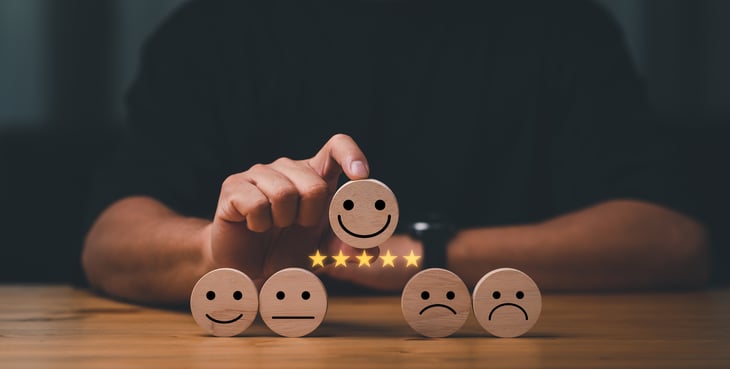Do "customer experience" and "customer service" mean the same thing? More importantly, how do these two relate to each other? Most business owners need help understanding the relationship between customer experience and customer service.
To prove this, a recent study by Bain & Company showed that organizations rate their quality of customer experience at 80% while only 8% of customers believed they receive a great customer experience. Another study also revealed that 85% of brands believed they offered a personalized customer experience, but only 60% of consumers did.
That means if your brand offers a good customer experience (CX), it's likelier to experience faster revenue growth than those who don't prioritize CX. In fact, stats by Zendesk show 75% of consumers today are willing to spend more on companies with a good customer experience.
Therefore, understanding your customers' needs, expectations, perceptions, and the evolution of their preferences is the key to learning how your brand can best deliver the desired experience. In this post, we explain what it means to have a good customer experience vs. customer service and how to give your customers an experience that will keep them coming back
What's the Difference Between Customer Experience vs. Customer Service?
The difference between customer service and customer experience is that customer service is just one part of the entire buyer journey, while customer experience includes all the interactions between your brand and a customer throughout the journey.
That means customer service is only limited to customer interactions when seeking advice or assistance on a product or service (also known as reactive experience). On the other hand, customer experience can involve analyzing data from non-customer-facing teams who contribute to a customer's overall experience with a product or service (referred to as proactive experience).
Benefit-wise, understanding the buyer experience gives you complete control over the service you provide to customers. In addition, your support teams can also gauge the quality of their customer service through metrics like customer satisfaction scores (CSAT) and improve.
What are the Consequences of Poor or Bad Customer Experience?
Technology has improved access to information and increased options for consumers today. As a result, most customers expect quick, easy, and frictionless experiences, or they will take their businesses elsewhere.
According to a recent survey, 58% of US consumers would consider walking away from purchases due to a bad customer experience. Another study also showed 91% of unhappy customers leave without even complaining.
Still, 65% of respondents today say they would become long-term customers of a brand if the brand provides positive experiences throughout the customer journey. But how do you do that? Well, the first step is to avoid the common causes of bad customer experiences. These include:
● Complex purchasing processes: If your customers find it challenging to maneuver your site or make purchases, it frustrates them, creating a bad experience. The same happens when customers look for a product on your site and find out it's out of stock.
● Negative experiences with customer support: Lack of etiquette and unknowledgeable customer service team members are some of the top negative experiences that increase customer churn rate.
● Compromising a customer's personal security: Every customer values a certain level of privacy –some a little more than others. Exposing critical consumer information like credit card details makes them feel unprotected, and they can never trust you with such information again.
● Waiting too long on hold: Putting your customers on hold for more than 3 minutes creates a bad experience. Many would never be willing to wait beyond that mark, and only a few dedicated customers can wait up to five minutes today.
● Ignoring customer feedback: Completely ignoring customer feedback and requests, even if it's just acknowledging receivership, creates a bad experience. Team members also create poor customer experiences by not creating emotional connections through feedback.
How to Provide a Great Customer Experience to Your Consumers
Delivering consistent positive customer experiences throughout the customer journey, including post-purchase is essential to customer retention, and turning first-time buyers into loyal customers.
Customer Experience leaders can create a great customer experience for their customers by leveraging the following:
- People: Customers want to speak to helpful and kind, passionate people, whether they're shopping or live in chat. When someone is passionate and well-informed about the product they're selling, they are inherently more successful.
- Technology: Technology helps to actively manage any potential roadblocks so you can turn insights into action plans. It provides visibility into each store that carries your product and allows you to drive strategy.
- Product: Customers want intuitive products that solve their problems. This is the brand touch point as it includes the marketing, the design, and the feelings your brand creates for your customer.
You can leverage the tools and knowledgeable agents to help you deliver these experiences to your customer base by:
Streamlining the Entire Customer Journey
Technology and Customer experience go hand-in-hand. One can't exist without the other. You can streamline your customer journey by connecting all communication channels in your buyer's journey. This way, you can get consistent feedback from customer onboarding to post-purchase, helping you deliver a quicker and better customer experience.
Equip Your Entire Team
Statistics show 46% of consumers will abandon a brand with unknowledgeable employees. Empower and train departments beyond your support team or service center to share customer care for an all-around unified experience.
Measure Customer Experience
How do you know if all this investment in your teams, process, and technology is working and paying off? Measuring customer experience is one of the biggest challenges faced by organizations.
It's only through customer experience technology tools like CSAT, Net Promoter Score (NPS), and customer effort score (CES) that support teams can measure customer experience. Teams can also use customer retention rate and customer churn rate to assess ROI from delivering excellent customer experience.
Get the Retail Customer Experience You Need With Third Channel
Most brands think they deliver exceptional Customer Experience when it's just customer service. Like most things in today's marketplace, customer experience has changed. It's more than a person-to-person service.
Thanks to technology, companies can connect with their customers in new and exciting ways, but customer experience is an area that still needs constant nurturing, care, and a greater focus on customer experience strategy for companies to realize a positive impact on customer loyalty, higher retention, and increased revenue growth.
Focusing on a customer's journey, and identifying the problems within them, offers new opportunities to create a great customer experience. Schedule a customized demo with ThirdChannel to find out how to increase your customer experience




